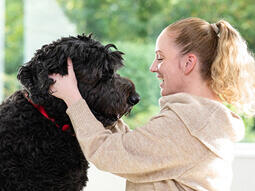
If you’re suspecting your dog is suffering from a case of conjunctivitis, here’s what you need to know. From causes to symptoms and treatment options, we’ve got you covered.
Does your dog seem to have irritated, bloodshot or weepy eyes? Are they blinking a lot or rubbing their face on you or the ground? If the answer is yes, your pooch might be suffering from a case of dog conjunctivitis. Much like the human version, canine conjunctivitis can appear out of nowhere, is unpleasant and will require professional attention. Here’s what you need to know about this condition.
What is dog conjunctivitis?
Dog conjunctivitis, also known as pink eye, is a condition caused by the inflammation of the conjunctiva, a thin, transparent membrane that covers the front part of the eyeball and lines the eyelid.
The conjunctiva is the eye’s protective barrier designed to protect the eye from dirt or bacteria. If you think your pet has conjunctivitis, it’s best to visit the vet as soon as possible as some of the causes can progress quickly.
What are the symptoms of dog conjunctivitis?
In humans, we can quickly notice when our eyes become red, itchy or sore, which makes conjunctivitis one of the easiest problems to spot. But in dogs, the white part of their eyeball is not as readily visible, especially if they have long eyebrow hair. So, it’s important to be on the lookout for other symptoms your pet might be experiencing. Here are some of the most common signs of conjunctivitis in dogs:
- Eye discharge (yellow or green)
- Squinting
- Watery eyes
- Eyelids that stick together
- Excessive blinking
- Rubbing their eyes
- Swollen eyelids
These signs may be accompanied by cold-like symptoms, such as a runny nose, which can indicate a virus.
What causes conjunctivitis in dogs?
Dogs love to explore every nook and cranny, but this also means they can easily get exposed to all sorts of triggering factors of conjunctivitis, from viruses or bacteria to material such as dirt or grass seeds that find their way into the eye. These are some of the most common causes leading to a swollen, red or weepy eye:
- Irritation from foreign objects (these are often hidden under the eyelids and can be hard to spot)
- Smoke, mould, dust or pollutants in the environment
- Dry eyes that don’t produce enough tears
- Allergies
- Other eye problems such as glaucoma or a tumour
- Injury of the eye area
- Shampoo that irritates the eyes
- Ingrowing eyelids or hairs rubbing on the surface of the eye
- Bacterial infection
- Viral infection
- Mites that affect the skin around the eyes
It can be difficult for pet owners to narrow down the list and get to the correct cause of their dog’s eye problem themselves, so it’s always best to ask the vet for advice. Determining the cause of conjunctivitis in dogs is important, as this will decide the most effective treatment for your pet.
Dog conjunctivitis treatment
With so many potential factors able to trigger dog conjunctivitis, there isn’t a standard treatment that can be applied in every case. This is why your vet will first establish the cause before recommending any course of action. Pain relief might also be needed as having a sore eye isn’t very pleasant for your dog.
If a foreign object is behind your dog’s eye problem, your vet will usually try and remove it. In some cases, this may require sedating your pet to make the process easier and remove the risk of your dog becoming too restless and causing an eye injury during the procedure.
If a bacteria or virus is the cause of your dog’s conjunctivitis, treatment in the form of antibiotics or antiviral medication will be recommended.
Sometimes a dog allergy can your eye symptoms. In this case as well, specific treatment will be prescribed such antihistamines or steroids. These may be given as tablets or eye drops, or sometimes both.
Sticky yellow or green eye discharge may also be a symptom that your dog’s ability to produce tears is impaired, leaving them with dry, irritated eyes. In this case the vet will recommend special eye drops or ointments to help with their dry eyes.
Should you go to the vet if you suspect your dog has conjunctivitis?
Yes, you should ask your vet for a consultation whenever you notice conjunctivitis-like symptoms. This is not a condition you want to ignore. Some causes of dog conjunctivitis can get worse very quickly and are often painful. By talking to the professional early on, you reduce the risks of more serious vision problems affecting your canine friend.
Things to avoid if your dog has conjunctivitis
It is never a good idea to try and offer some relief to a distressed pooch with a pink eye by using eye drops for humans. Until you know the cause, it’s impossible to know what medication is needed. The ingredients in human medications can be dangerous for dogs. Saline eye drops specifically created for pets do exist and are available in pet stores and pharmacies. These can be helpful to flush out any irritants while waiting for your vet appointment. However, it’s usually safest to call your vet first to ask their advice.
Eyes are extremely sensitive and any dirt, irritants or bacteria present on your hand can make your dog’s already pink eye even worse. So, if you notice any of the dog conjunctivitis symptoms above and you want to check your dog’s eyes yourself, make sure you wash your hands first.
How to prevent conjunctivitis in dogs
Unfortunately, there is no sure way to protect a dog from getting conjunctivitis. The potential triggers are all around and your dog’s sniffing missions might get them straight into the path of dust, mould or bacteria, all possible causes of conjunctivitis. But there a few things to be mindful of:
Viruses finding their way to your dog’s eye can cause infectious conjunctivitis. Fortunately, the usual vaccines your pet gets will make sure these viruses don’t cause any problems. You can find out more about dog vaccination with our handy article.
Taking an inventory of the elements usually present in your dog’s environment can also help. Look out for cleaning products, smoke sources and mould that your dog might get into contact with on their daily explorations. Even a waft of perfume can be enough to irritate your dog’s eyes. So, eliminating some of these common triggers of dog conjunctivitis can prevent this eye problem from affecting your pooch.
A dog cone won’t prevent conjunctivitis, but it can help prevent it getting worse. A dog’s first instinct will usually be to scratch the itch by rubbing either their face on the ground or their affected eye with their paws. This can make the irritation go from bad to worse very quickly. So, using a cone can help to protect their eyes while you’re waiting for the treatment to start working.
Can humans catch conjunctivitis from a dog?
Humans can catch conjunctivitis from their pet, but this is fortunately a rare occurrence. If you’re also wondering “Can dogs get conjunctivitis from humans?” the answer is yes. This is possible and owners suffering from conjunctivitis should make sure they wash their hands before cuddling with their furry best friend.
Its important to keep an eye on your dogs eyes for any changes. read our articles on weepy eyes in dogs or cherry eyes for more information.
Next, discover more about dog allergies, one of the potential causes of dog conjunctivitis.















